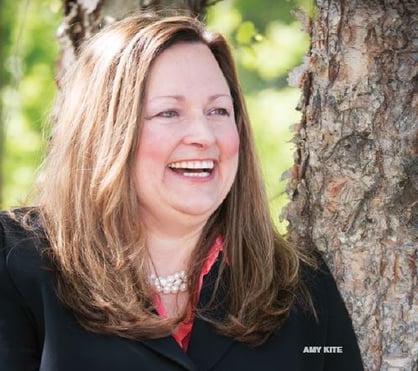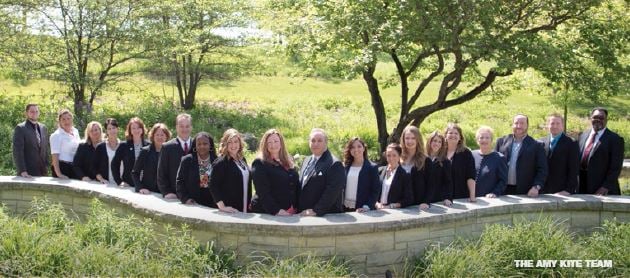When it comes to success in real estate, the conventional wisdom is laser-focused on local marketing. But, as Gary Keller teaches, it pays to think bigger. Just ask Amy Kite of The Kite Team in the Naperville, Ill., market center, which services eight counties surrounding Chicago. Here she shares tips you can use to double your production in just one year. Kite joined Keller Williams Realty in 2005. Prior to that, she had been in the business less than a year with another company when she attended a Keller Williams training class offered at the Barrington (Ill.) market center.
She says she was never pressured to join the company even though she was taking the class, but she loved the culture and the commitment to training – it was a perfect fit for the self-proclaimed “education junkie.”
Fast forward to 2015, Kite’s 13-person team closed $73 million in 485 transactions – up from slightly more than half of that in 2014. How did she go from a solo real estate agent to the head of a growing team and a multimillion-dollar business with such a significant year-over-year jump in revenue? It was a process, she says.
Getting the Fundamentals Right
When someone asks Kite what the secrets are to building such a big business, her first response is, “The database.” Building a solid database and establishing regular ways of communicating with your contacts and clients is essential. Real estate is a business highly dependent on referrals, and it’s critical to keep in touch and remind people that you’re out there.
Kite also invests in education and networking opportunities to meet other successful KW agents from whom she can learn. She initially attended BOLD in 2009 when it first came to Chicago and has returned a total of 12 times. When asked why she has attended so many times, Kite says it stopped being about the real estate component after about the fifth one and became about the mindset and accountability that the program promotes.
“BOLD is about who you can become. Do you believe you can become somebody spectacular? Do you believe that having a mindset shift can help you, whether it is in business or in your personal life or wherever?” she says. “The funny thing is that after you’ve taken it a dozen times, you look at people differently and sometimes you think, ‘Aw, you just need BOLD.’”
Her BOLD training also helped her understand that, in order to grow, she needed to invest in team members to keep the momentum going. When she first added an assistant in 2007, she more than doubled her business.
Getting Big Fast
Three years ago, Kite started targeting and working with builders in the Chicago area as a member of the Builder Trade-In program, helping their buyers rent or sell their “contingencies” – the houses they needed to sell in order buy the builders’ properties. Because Kite was suddenly working throughout the eight counties surrounding Chicago, she had to expand her reach – and her team. Up until that point, she operated everything with her assistant/office manager. But, now she needed buyer agents, listing agents, and other team members to handle the volume.
As her employee base began to grow, she would note the areas where team members began to feel overwhelmed or where she saw potential to build her business, and invest there.
“Keller Williams is not about ‘what.’ Many times, it’s about ‘who.’ Who are you missing? What piece are you missing there? We had to find the right people to solve our process problems,” she says.
She says BOLD was essential to her success here too. After her fifth time at BOLD, she realized she needed to hire a person strictly to handle her database. After that BOLD session, she realized that she could spend $50,000 per year on that person to generate $150,000 in business from her database. She made the hire, and it worked. Today, Kite’s team has 19 people in addition to her, including two listing agents, six buyer agents, two transaction coordinators, a property manager/rental specialist, a receptionist, a vice president of technology, a director of operations, three inside sales associates (ISAs), a photographer/runner and a driver.
She hired seven of those people in the past five months. One of the biggest boosts to her productivity was hiring a driver roughly two years ago, she says. The long hours on the road were taking their toll. One night, she got home at 9 p.m., took five hours to prepare for the next day, climbed into bed at 2:30 a.m. to get a couple of hours of sleep before she had to rise again at 5 a.m. She started to cry. Her husband was alarmed and asked her what was wrong.
“I said, ‘If I don’t get a driver, I’m going to kill myself and someonem else because I’m going to fall asleep on the road,” she recalls. While it seems like an extravagant move, Kite now works as she travels between appointments. She says she gets most of her work done as she sits in the backseat, and instead of spending her at-home hours prepping for the next day and catching up on work, she actually spends time with her family.
Finding the Right Solutions

By establishing systems for handling everything in her office, she can free herself from the dayto- day and more efficiently work on what she does best. When a buyer lead comes in, it goes to one of the buyer agents. When a listing comes in, it’s routed appropriately to an ISA. For buyers, the team conducts an in-depth consultation to narrow options and makes the search smooth and effective. They deliver properties that match the buyers’ requirements within 12 hours of them coming on the market. Sellers receive a thorough market analysis of Multiple Listing Service (MLS) and private sales along with free home staging, home warranty and a customized Realtor.com® listing.
Kite’s staff schedules everything for her, right down to her phone calls. They are only permitted to schedule her for 15 to 20 listing appointments each week to keep her time free to work on building the business in other ways.
“If it’s not on my schedule, it doesn’t exist,” she says, quoting one of the BOLD laws. She’s also highly focused on testing the marketing tactics that work best. When she began working with builders in so many counties, she expanded into radio and television advertising for its greater reach, which worked enormously well for them. Since digital marketing is so important, her vice president of technology constantly works on her team’s websites, keeping them updated and optimized.
Constantly examining what is working and reinvesting in those methods is critical, she says. Despite her rigor in establishing systems and following the playbook for building a successful real estate business, Kite isn’t afraid to do what works for her, even when it flies in the face of conventional wisdom.
Selling in eight Chicago-area counties is practically unheard of, she says. But she and her team are doing it well. While other agents shy away from selling in the winter months, Kite is enthusiastic and does brisk business from November through February.
While some see Chicago’s brutal winters, Kite sees a timeline with far less competition.
Her BOLD training and large network of contacts has helped her take the road less traveled. Kite makes it a point to attend conventions to meet other real estate agents and learn from them. In addition to regular BOLD sessions, she attends Agent Masterminds, where she learns a great deal from the agents who attend.
Recharge is another favorite of Kite’s because it’s an opportunity to network with and learn from operating principals (OPs), regional directors (RDs), team leaders (TLs) and others who have reached the upper levels of the business model.
She also likes to interact with people in other businesses to see if she can find new solutions to apply. “You can’t just focus on masterminding with people who are like you and in the same position. There’s a ton of value in masterminding with people who are running businesses differently, whether it’s in real estate or not,” she says.


 Now with the Career Growth Initiative (CGI) Keller Williams associates have a similar tool called the Daily GCI tool to help them identify when they've covered operating costs and are beginning to make profit.
Now with the Career Growth Initiative (CGI) Keller Williams associates have a similar tool called the Daily GCI tool to help them identify when they've covered operating costs and are beginning to make profit.


 Ken Wimberly, a mega agent within the market center, has already experienced this. This year, his commercial real estate business will surpass $100 million in sales volume and he credits it to the Keller Williams models and systems.
Ken Wimberly, a mega agent within the market center, has already experienced this. This year, his commercial real estate business will surpass $100 million in sales volume and he credits it to the Keller Williams models and systems. In the upcoming new edition of The Millionaire Real Estate Agent(MREA), the 33 Touch is reimagined and changed to 36 to Convert. During the presentation, Papasan walked attendees through the 36 client touches agents can make each year to exponentially increase their business.
In the upcoming new edition of The Millionaire Real Estate Agent(MREA), the 33 Touch is reimagined and changed to 36 to Convert. During the presentation, Papasan walked attendees through the 36 client touches agents can make each year to exponentially increase their business.



 By establishing systems for handling everything in her office, she can free herself from the dayto- day and more efficiently work on what she does best. When a buyer lead comes in, it goes to one of the buyer agents. When a listing comes in, it’s routed appropriately to an ISA. For buyers, the team conducts an in-depth consultation to narrow options and makes the search smooth and effective. They deliver properties that match the buyers’ requirements within 12 hours of them coming on the market. Sellers receive a thorough market analysis of Multiple Listing Service (MLS) and private sales along with free home staging, home warranty and a customized Realtor.com® listing.
By establishing systems for handling everything in her office, she can free herself from the dayto- day and more efficiently work on what she does best. When a buyer lead comes in, it goes to one of the buyer agents. When a listing comes in, it’s routed appropriately to an ISA. For buyers, the team conducts an in-depth consultation to narrow options and makes the search smooth and effective. They deliver properties that match the buyers’ requirements within 12 hours of them coming on the market. Sellers receive a thorough market analysis of Multiple Listing Service (MLS) and private sales along with free home staging, home warranty and a customized Realtor.com® listing.